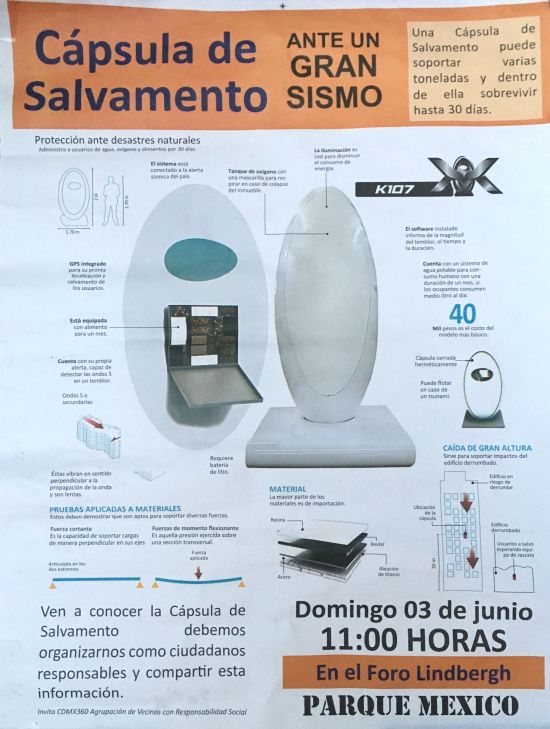
This is a photo of a poster I found taped to a telephone pole in front of my apartment building in Mexico City.
CDMX360, "Technology", contributed by Emily Vasquez, STS Infrastructures, Platform for Experimental Collaborative Ethnography, last modified 16 August 2019, accessed 11 April 2025. https://stsinfrastructures.org/content/technology
Critical Commentary
Eight months have passed. The building next door to mine remains empty. Construction crews are working, now in daylight. We no longer stop what we are doing when we hear a siren, worried it’s the city’s earthquake alarm.
I do stop to read a poster taped to a telephone pole in front of my apartment building. I am taken aback: “Rescue Capsule”. The poster depicts what appears to be a large egg. It is 2 meters tall. It is made for a single human. It is built to withstand the impact of a building collapsing upon it. “In Case of a Great Earthquake,” the poseter reads.
Inside the capsule, its inhabitant can survive for 30 days, with water, oxygen and nutrients. LED illumination. It can float should there be a tsunami. It has an alarm built in and can alert you to an earthquake on its own. It has a GPS so that it can be located by rescuers. It requires a lithium battery. The basic model runs 40 thousand pesos, around 2000 dollars.
The poster invites me to find out more on Sunday, June 3 at 11 am at a meeting in the park. “We must organize ourselves as responsible citizens and share this information,” the poster reads. It is signed: Social Responsibility Neighborhood Collective.
I show my friend the poster. She laughs, “neoliberalsismo”. The word “sismo” is earthquake in spanish. She is right. This technology fuses it with “neoliberalismo”. I google “cápsula de rescate”. I find news coverage celebrating the “boom of anti-earthquake capsules”. The inventor has won a Civil Engineering prize of Mexico City.